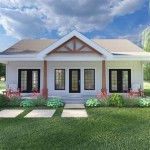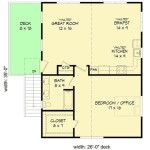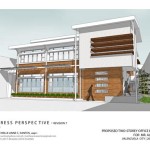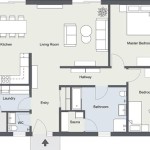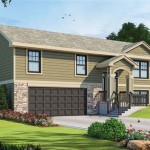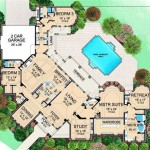Home Plans with In-Law Suites: A Comprehensive Guide
The concept of multi-generational living is experiencing a resurgence, driven by factors such as rising housing costs, the desire for closer family bonds, and the increasing need for elder care. This trend has fueled the demand for home plans with in-law suites, also referred to as accessory dwelling units (ADUs), granny flats, or mother-in-law apartments. These suites offer independent living spaces within a larger residence, allowing families to live together while maintaining privacy and autonomy. This article provides a comprehensive overview of home plans with in-law suites, covering their benefits, design considerations, legal aspects, and potential impact on property value.
An in-law suite is essentially a self-contained living area within a larger home, designed to accommodate one or more individuals. Typically, it includes a private bedroom, bathroom, living area, and kitchenette or full kitchen. The suite may be attached to the main house, detached in the form of a separate building on the same property, or located above a garage. The key characteristic is its provision of a functional and independent living space, separate from the primary residence but still integrated within the overall property.
The popularity of in-law suites reflects a growing need for flexible housing solutions. These suites can serve various purposes, extending beyond simply housing in-laws. They can provide accommodation for adult children returning home, caregivers, renters, or even act as a home office or recreational space. The adaptability of these spaces makes them a valuable asset for homeowners seeking to maximize the utility of their property.
Benefits of Incorporating an In-Law Suite into Your Home Plan
Integrating an in-law suite into a home plan offers numerous advantages, addressing both practical needs and emotional desires. Understanding these benefits can help homeowners determine if incorporating a suite is the right choice for their specific circumstances.
One of the primary benefits is the facilitation of multi-generational living. This arrangement allows families to provide direct care and support to elderly parents or other relatives without sacrificing independence. The proximity allows for regular interaction, shared meals, and assistance with daily tasks, fostering stronger family bonds and reducing the potential need for costly assisted living facilities. This can be particularly beneficial when dealing with elderly relatives who may need assistance, helping to reduce stress and enable more efficient provision of care.
From a financial perspective, an in-law suite can provide a supplementary income stream. Renting out the suite to tenants can help offset mortgage payments, property taxes, or other household expenses. This can be especially helpful in high-cost-of-living areas, where rental income can significantly contribute to financial stability. In addition, the presence of a suite can increase the overall property value, making it a worthwhile investment for future resale.
In-law suites offer increased flexibility in terms of accommodation. The suite can be readily adapted to meet changing needs over time. For example, a suite initially used for in-laws may later serve as a home office, a guest room, or a dedicated space for adult children. This adaptability ensures that the suite remains a functional and valuable asset throughout the homeowner's lifecycle.
Design Considerations for In-Law Suite Home Plans
Designing an in-law suite requires careful planning and consideration of various factors to ensure it meets the needs of both the occupants of the main house and the suite. The design should prioritize accessibility, privacy, and functionality, creating a comfortable and independent living space.
Accessibility is paramount, especially if the suite is intended for elderly or disabled individuals. Features such as wider doorways, grab bars in the bathroom, and a ramp or elevator for access to upper levels should be incorporated. Universal design principles, which aim to create spaces that are usable by people of all ages and abilities, should be applied throughout the suite. Consideration should also be given to the ease of navigation within the suite, minimizing obstacles and ensuring a clear and unobstructed path for walking.
Privacy is another crucial consideration. The suite should have a separate entrance to minimize disruption to the main house. Soundproofing the walls and floors can also help to reduce noise transmission between the two living spaces. The layout of the suite should be designed to maximize privacy, with bedrooms and living areas positioned away from shared walls or common areas. Thoughtful landscaping can provide visual screening and further enhance privacy.
Functionality is essential for creating a comfortable and independent living space. The suite should include a well-equipped kitchenette or full kitchen, a private bathroom, a comfortable living area, and ample storage space. The layout should be efficient and practical, making the most of the available space. The suite should also have its own heating and cooling system, allowing occupants to control the temperature independently. Adequate lighting, both natural and artificial, is also important for creating a welcoming and functional environment. Furthermore, the suite should be designed to blend seamlessly with the overall architectural style of the main house, maintaining a cohesive and aesthetically pleasing appearance.
Legal and Regulatory Aspects of In-Law Suites
Before constructing or modifying a home to include an in-law suite, it is essential to understand the applicable laws and regulations. Zoning ordinances, building codes, and homeowners association rules can significantly impact the feasibility and legality of adding a suite.
Zoning ordinances typically regulate the types of structures that are permitted on a property, as well as their size, placement, and use. Many municipalities have specific regulations regarding accessory dwelling units (ADUs), which often include in-law suites. These regulations may specify minimum and maximum size requirements, setbacks from property lines, parking requirements, and occupancy restrictions. It is crucial to consult with the local zoning department to determine the specific regulations that apply to your property and to ensure that your plans comply with these regulations.
Building codes establish minimum standards for the construction and safety of buildings. These codes cover aspects such as structural integrity, fire safety, electrical wiring, plumbing, and ventilation. Obtaining the necessary building permits is essential to ensure that the construction of the in-law suite meets these standards. A building inspector will typically review the plans and inspect the construction to verify compliance with the building codes. Failure to obtain the necessary permits or to comply with the building codes can result in fines, stop-work orders, or even the requirement to remove the unpermitted construction.
Homeowners association (HOA) rules may also restrict or prohibit the construction of in-law suites. HOA rules often govern the appearance and use of properties within the community. Some HOAs may prohibit the construction of separate living units, while others may impose restrictions on the size, design, or use of such units. It is important to review the HOA rules and to obtain any necessary approvals before proceeding with the construction of an in-law suite. Failure to comply with the HOA rules can result in fines or legal action.
In addition to zoning ordinances, building codes, and HOA rules, there may be other legal considerations to keep in mind. For example, if the in-law suite is being rented out, it may be subject to landlord-tenant laws. These laws regulate the rights and responsibilities of landlords and tenants, including issues such as rent control, eviction procedures, and security deposits. It is important to understand these laws and to comply with them if you are renting out the in-law suite.
Property taxes may also be affected by the addition of an in-law suite. The assessment of the property may increase, resulting in higher property taxes. It is important to consult with the local tax assessor to determine the potential impact on your property taxes. Additionally, income earned from renting out the in-law suite may be subject to income tax. It is advisable to consult with a tax professional to understand the tax implications of constructing and renting out an in-law suite.
Navigating the legal and regulatory aspects of in-law suites can be complex. Consulting with legal and construction professionals familiar with local regulations is highly recommended. These professionals can provide guidance on zoning requirements, building codes, permit applications, and other legal considerations, ensuring that the project is compliant and avoids potential issues.
Ignoring these legal requirements can lead to expensive rework, fines, or even the forced removal of the suite. By diligently researching and adhering to all applicable regulations, homeowners can ensure that their in-law suite is a legal and valuable addition to their property.

House Plans With In Law Suites Kitchens Blog Floorplans Com

Front Side View House Plans With A Separate In Law Suite

House Plans With In Law Suites Kitchens Blog Floorplans Com

House Plans With In Law Suites Houseplans Blog Com

Southern Style House Plan With In Law Suite

In Law Suite Plans Give Mom Space And Keep Yours The House Designers

Exclusive Brick Clad House Plan With Mother In Law Suite

House Plans With In Law Suites Houseplans Blog Com

Adding An In Law Suite To Your Home Designing Perfect House

House Plans With In Law Suites Houseplans Blog Com

